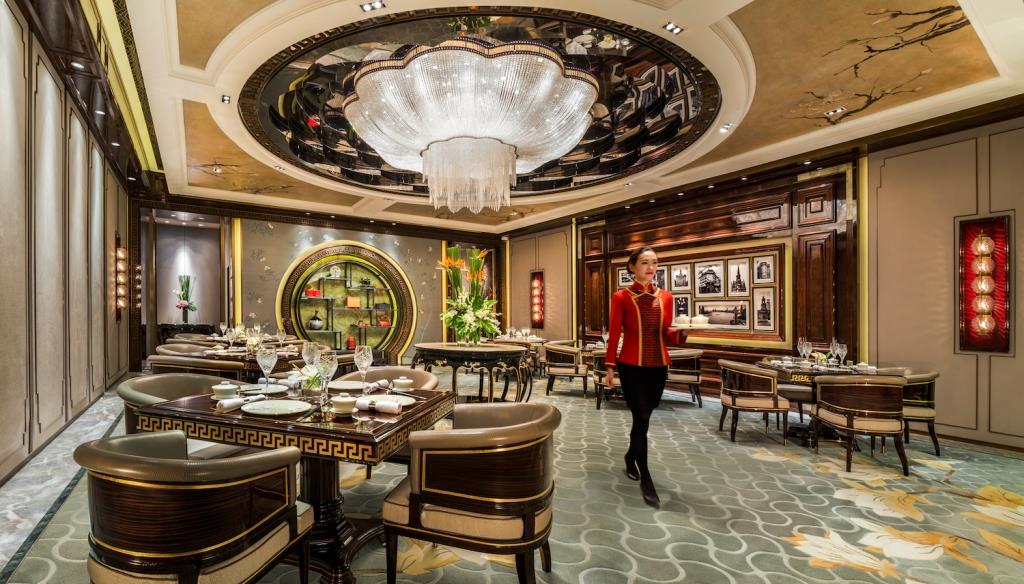Food Review: River Drunk, Wanda Reign on the Bund, Shanghai
The Art of Chinese Fine Dining
To begin this food review, one must needs trace one’s footsteps from the utterly magnificent lobby – a humungous, square expanse of marbled space, featuring one large painting of a Chinese scene in a riot of colours that dominates an entire wall. Placed at four strategic corners are pairs of high-backed chairs in black, giving off a dignified, royal air. That’s it – there is nothing, absolutely nothing else in this vast hall; the Reception area is strategically hidden behind this. The entire ambience is that of some hushed, art museum; of understated opulence, of a luxury beyond vision and of a hospitality not constrained by the usual ideas of hoteliering.
Alighting from the lift in front of River Drunk, the somewhat casual name belies what one can expect. This is Chinese fine dining at its best, within an elegant and discreet ambience. Polished grey marble flooring gives on to a light grey carpet with mustard flowers and the whole offsets exquisitely appointed interiors, based on the designs of mansions of the royals who lived along the Yangtze river in ancient China.
There are just six tables, with four grey armchairs each. The delicately painted ceiling has Chinese flower motifs across it, from which a huge, circular chandelier rests snugly on a black dome and is reflected in all its glory in the highly polished black glass of the tables. One wall is hung with black-and-white photographs mounted on a rich, wooden frame, of the Shanghai of yesteryears, while the wall opposite has panels in black inscribed with Chinese verses. The piece de resistance is a circular space cut into the front-facing wall and decorated with Chinese artefacts. The crockery is utterly elegant, with flower-patterned plates in thin porcelain.
Chef Kevin Cai at the River Drunk is from Huangzhou and the cuisine served here is Huaiyang, from the provinces of Huangzhou and Jiangsu and featuring the native cooking styles from Anhui, Jiangsu, Shanghai and Zhejiang. Fresh seafood is the central focus of the menu and chef Kevin keeps it simple, cooking with minimal flavours that do not override the original taste of each ingredient or meat.
An appetiser selection consisting of tiny portions was presented more like an art collage, in keeping with the entire hotel theme. There was a wild vegetable salad shaped like a tiny round ball, a bean curd roll, two pale pink curled shrimps, sea wilks (whelk) with a delicate spicy flavour and lotus root with sticky rice. This was followed by a consommé of double boiled fungus and wild mushrooms. Next up was the sautéed hand peeled river shrimp with Longjin tea; these are really tiny shrimp but with a most tender, almost sweetish flavour and are eaten the Chinese way dipped in vinegar or else, soy sauce.
This course was followed by the steamed spotted Garoupa fish in soy sauce. This fish may not be to everybody’s taste, as it has an extremely thick, fleshy skin.
My companion Stefie, the Director of Marketing Communications at Wanda Reign on the Bund and I then tried the Forest Bean Curd with Vietnamese spring roll skin, accompanied by some broccoli on the side. The bean curd was enclosed within the Vietnamese spring roll sheet and the whole was wrapped like a money pouch; inside the bean curd were finely sliced lotus root and mushrooms. The crunchiness of the lotus root was delightfully offset by the soft texture of the bean curd.
We then moved to the Yangzhou style fried rice; thankfully, this came as a small soup bowl portion, as we were quite stuffed by this point. The rice was a blend of peas, shrimps and eggs; using jasmine rice from Thailand, each grain was separate and distinct. One could be forgiven for assuming that there was a tinge of monosodium glutamate (MSG) in the rice, however, that turned out not to be the case, as the Wanda Reign on the Bund is strictly against using MSG in its kitchens. What was used though, to impart that subtle flavour, was “umami.” The word is Japanese in origin, because it was a Japanese professor from the University of Tokyo – Kikunae Ikeda – who first identified its taste in 1908; it is the taste of ‘savoury’ – one of the five basic tastes along with sweet, sour, salty and bitter. (We get the taste of umami due to carboxylate anion of glutamate in special receptor cells that are there on the human tongue and adding salt further enhances the taste. Although glutamate in acid form imparts very little umami taste, the salts of this acid called glutamates, give the characterized umami taste due to their ionized state.)
We finally rounded off this repast with seasonal fresh fruits and a traditional dessert of southern style dimsum, which is actually a steamed, sweet rice cake containing a red bean stuffing. Served slightly warm, it was accompanied by nostoc in syrup with a pear roundel. Nostoc is popular in China and Japan; quite bland in taste, it is a gelatinous mass of filaments of moniliform cells. Found at the bottom of lakes and springs, it swells up after rain and is also sometimes known as “witches’ jelly.”
River Drunk is open for lunch service from 11.30am to 2.30pm and for dinner from 5.30 until 10.30pm. Apart from the main dining space, there are six private dining rooms (PDR’s) such as the ‘Spring’, ‘Autumn Lotus’, ‘Winter Plum Blossom’, ‘Peony’ and ‘Magnolia’ for more intimate gatherings, which can accommodate from 6-30pax, while ‘The Wanda’ can be used for state banquets. The restaurant also has its own wine cellar.
For reservations, please contact +86 21 5368 8854 or email [email protected]














